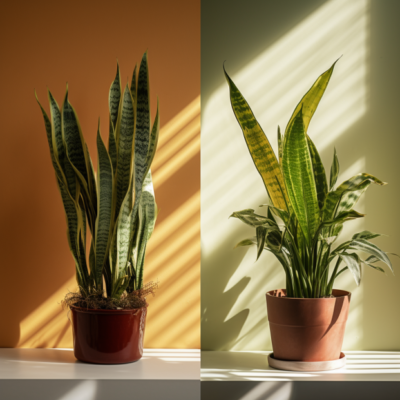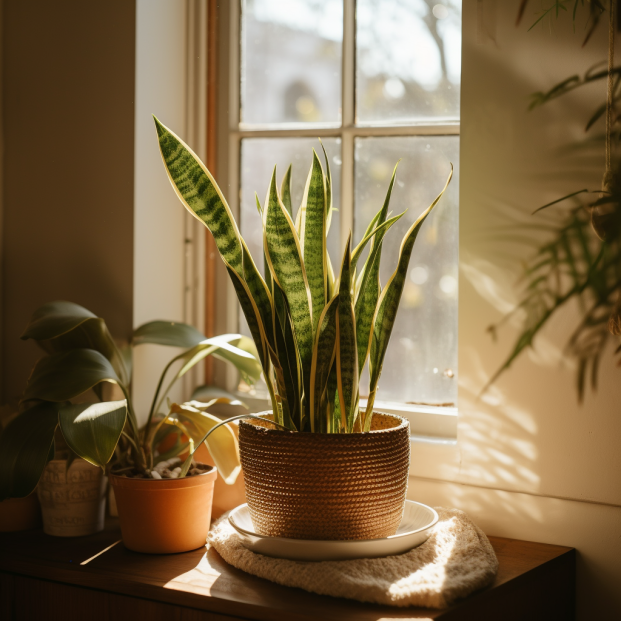According to Garden Benchtop, a frozen snake plant can result from exposing your plant to freezing temperatures. (1)
If you discover parts of your beautiful snake plant have frozen, it can be devastating.
However, the good news is your plant can be saved.
This troubleshooting guide will explain the symptoms to look out for and the following steps to remedying your damaged plant.
If you want to learn how to prevent a frozen snake plant in the future, check out our comprehensive guide to snake plant care.
KEY TAKEAWAY
How to save your frozen snake plant?
To save a frozen snake plant, act promptly with specific measures like relocating and gradual warming, considering the extent of damage.
Prevention is key – safeguard your snake plant during winter with adequate protection, monitoring, and proactive care to avoid freezing.
Decoding Frozen Snake Plants: Causes and Symptoms
Snake plants can survive temps as low as 30 degrees. (2)
But any colder and freeze damage happens.
Icy weather turns their moisture to ice crystals that puncture soft plant tissues.
Once temperatures warm after a hard freeze, the sharpest signs your snake plant suffered cold damage are:
- Black, mushy leaves and stems. This is the most obvious red flag. Cold killed the plant cells.
- Drooping, wrinkled foliage that was once firm. It has lost structural water.
- Slow growth the next season or no new shoots. Roots and crowns may be too damaged.
The severity depends on factors like:
- Exposure duration – Brief dip below freezing vs weeks of cold
- Temperature extremes – 25°F vs 10°F
- Time of year – Growing season vs dormancy
Check both soil and air temps hurt your plants. Drafty windows also create localized cold pockets.
While snake plants resist drought, saturated soil freezes more easily.
So poor drainage raises risk. Sheltered tropicals suffer most when they shouldn’t face frost at all.
Essential Tools for Snake Plant Winter Care

Here’s a list of recommended tools for snake plant winter care:
Indoor Thermometer
- Description: Tracks low temperatures that can harm plants, enabling you to monitor conditions that may trigger damage.
- Why This Tool is Recommended: Staying informed about indoor temperature allows proactive measures to protect your snake plant from potential frostbite by adjusting its placement accordingly.
Soil Moisture Meter
- Description: Checks if the soil is too saturated, helping prevent overwatering—a significant threat during winter dormancy.
- Why This Tool is Recommended: Overwatering is common in winter, and this tool ensures you provide the right amount of moisture, preventing root rot and related problems.
Sharp Pruning Shears
Prices pulled from the Amazon Product Advertising API on:
Product prices and availability are accurate as of the date/time indicated and are subject to change. Any price and availability information displayed on [relevant Amazon Site(s), as applicable] at the time of purchase will apply to the purchase of this product.
- Description: Essential for removing damaged leaves and stems, preventing the spread of deadly rot that could jeopardize the plant’s survival.
- Why This Tool is Recommended: Prompt pruning of affected parts is crucial for overall plant health, stopping the progression of damage and encouraging new, healthy growth.
Grow Lights
- Description: Deliver optimal indoor brightness, compensating for lost sunlight during winter and helping to revive growth.
- Why This Tool is Recommended: In the absence of sufficient natural light, especially during winter, providing additional artificial light ensures the snake plant gets the energy it needs for recovery.
Humidity Meter
- Description: Monitors moisture levels in the air, counteracting dry winter conditions that can slow down the recovery process.
- Why This Tool is Recommended: Maintaining adequate humidity is crucial, especially in dry indoor environments during winter, to support the snake plant’s overall well-being and growth.
Cactus Soil Mix
- Description: Ensures quick drainage, avoiding saturated soil that can lead to root death.
- Why This Tool is Recommended: Snake plants prefer well-draining soil, and this mix helps prevent waterlogged conditions, reducing the risk of root-related issues.
Liquid Fertilizer
- Description: Restores depleted nutrients, energizing growth after a cold starvation period.
- Why This Tool is Recommended: Winter can deplete the soil of essential nutrients, and providing liquid fertilizer ensures that the snake plant receives the necessary nourishment for recovery and new growth.
Emergency Care: Immediate Steps for a Frozen Snake Plant
Snake plants are survivors and might rebound if roots pull through. Acting quickly can possibly save your frozen plant:
1. Move it indoors immediately – Get it away from any remaining cold exposure.
2. Reduce watering – Don’t add moisture to already damaged frozen tissue.
3. Prune mushy parts with sterile shears – Remove any clearly dead leaves/stems to reduce rot spread.
4. Provide bright, indirect light – Gradually reacclimate it to indoor conditions.
5. Wait and watch for signs of recovery – Be patient as cold-stunted growth resumes slowly.
With attentive rehab, you might nurse your snake plant back if the freeze wasn’t too extreme.
But if most leaves blacken and roots die, replanting may be the only fix.
Harsh winters serve grim reminders to shelter our snake plant friends.
Assessing Damage: Is Your Snake Plant in Critical Condition?

Judging on how badly your snake plant is hurt from cold takes some plant CSI skills. Compare evidence to gauge the severity:
Moderate Issues
- Few browned leaf tips
- Wrinkled or curled leaves
- Slowed growth
These show cold stress. But with proper care, less damaged plants rebound.
Extensive Damage
- Leaves mushy or translucent
- Blackened stems
- Foul odor signaling rot
- No new shoots after months
If most plant tissue dies, the prognosis is poor even with treatment. Focus care on any sections still showing signs of life.
Check both soil moisture and roots. Healthy plump roots still absorb water. They transport nutrients to regenerate damaged tops. Root condition strongly predicts recovery potential.
Winterizing Your Snake Plant: Proactive Prevention Techniques
An ounce of prevention safeguards your plant. When winter approaches, be proactive:
- Move pots inside well before night temperatures drop below 50°F.
- Cut back on watering from fall through winter. Too much moisture while dormant risks root rot.
- Give bright, indirect light from a south window to mimic outdoor conditions.
- Maintain average room temperatures between 60-75°F.
- Check soil moisture monthly. Water only if soil is completely dry 1-2 inches down.
- Wait until night temps stay above 50°F in spring before moving back outside.
Sheltering snake plants over winter prevents exposure to potentially devastating freezes.
Apply these simple tips so cold weather won’t give your plants the chills next year!
Surviving Winter: Best Practices for Snake Plant Care in Cold Seasons
The snake plant, also called sansevieria trifasciata or mother-in-law’s tongue, is known as one of the hardiest houseplants around.
While it can tolerate low light and inconsistent watering, freezing winter temperatures can still stress the plant.
Follow these tips to keep your snake happy even when it’s cold outside:
- Check soil moisture monthly – snake plants need less water in winter. Soil should be dry 2 inches down before watering.
- Give bright, indirect light from a south or west window. Some direct sun is OK. More light keeps growth steady.
- Water with room temperature water only. Very cold water shocks roots.
- Mist leaves occasionally to boost humidity. Cold, dry air removes moisture.
- Repot root-bound plants in a gritty, well-draining soil mix. This prevents soggy soil.
- Move plants away from drafty windows and vents. Sudden temperature changes harm them.
Reviving Hope: Practical Solutions for Cold-Damaged Snake Plants

Even hardy snake plants can suffer freeze damage if winter temperatures dip too low. Leaves may turn brown and mushy when frozen.
Don’t give up too fast though – the plant can possibly recover.
Follow these revival methods:
- Cut off any fully frozen, damaged leaves with sterile shears. Healthy leaves fuel new growth.
- Inspect roots and remove any that are dark and mushy. Repot in fresh, dry soil.
- Place in a warm area (65-80°F) with bright, indirect light. Slowly harden off before going outside.
- Water lightly only when the top several inches of soil are fully dry. Too much moisture worsens rot.
- Mist leaves daily for added humidity. Cold air removes moisture quickly.
- Wait patiently for signs of new growth. This indicates the plant is recovering.
With attentive care focused on moisture, light, and warmth, even damaged snake plants can make an amazing comeback. Don’t let Old Man Winter get your plant down!
Beyond Thawing: Long-term Strategies for Snake Plant Resilience
Snake plants, also known as dracaena trifasciata or mother in law’s tongue, can withstand some cold weather but extreme cold can damage them.
If your snake plant freezes solid or shows signs of cold damage, here are some tips to help it recover and make it more resilient to future cold stresses:
Monitor For Signs of Cold Stress
- Check leaves and stems for mushy, darker areas which indicate frozen plant tissue.
- Wilting and drooping leaves also signal cold damage.
Allow The Plant to Thaw Slowly
- Do not expose frozen plants quickly to warm temperatures.
- Let it thaw over several hours to days on its own. Rapid thawing risks further tissue damage.
Trim Damaged Growth
- Once thawed, cut off any very mushy or dark, water-soaked leaves and stems.
- This prevents rotting and disease. New, healthy growth will emerge.
Adequately Water
- Snake plants prefer soil to dry between waterings, but after cold damage, keep soil consistently damp. This encourages recovery.
Use Plant Food
- Apply a balanced liquid fertilizer every 2-4 weeks during the growing season. This provides extra nutrients to fuel regrowth.
Alter Its Location
- Consider moving pot inside or to a warmer area protected from wind and cold if freezing weather returns.
- An indoor location is ideal to prevent repeat exposure to extreme cold.
With attentive care and preparation for winter, your snake plant can fully recover from cold damage.
Implement proactive measures so it can withstand even icy temperatures in the future without harm.
The key is adapting to prevent another freeze.
Frequently Asked Questions
Can frozen snake plants survive root rot?
Root rot is a common issue for snake plants during the winter months when soil stays continuously moist.
Ensuring the soil is dry between waterings can help prevent root rot from killing an otherwise frozen snake plant.
How can I keep my plants safe from cold temperatures?
Moving houseplants indoors before the first hard freeze is the best way to protect tropical plants like snake plants from extreme temperatures.
Bring plants in before nighttime lows reach the mid 40s F or lower.
Bright indirect light and room temperature conditions will keep frozen snake plants comfortable through the winter growing season.
What should I look for in a potting soil mix for snake plants?
Well-draining potting soil is important to prevent overwatering, which can lead to root rot.
Look for a soil mix containing components like perlite or bark that allow for good drainage.
This will keep the soil from getting soggy even after watering frozen snake plants.
How do I treat frozen or mushy leaves on my snake plant?
Soft and mushy leaves are often the first visible sign a snake plant has been frozen.
If the leaves still feel pliable, try placing the pot in indirect sunlight and monitoring for new growth.
If leaves are brown and mushy, remove them to avoid rot spreading.
Frozen snake plants often push out new leaves in spring with good growing conditions.
What causes brown spots on snake plant leaves?
Brown spots could indicate the soil is staying too wet for long periods.
Ensure the soil mix has adequate drainage and only water when the top inch of soil is dry.
Overwatered snake plants are more prone to pests and disease.
Allowing the soil to dry out fully between waterings helps prevent brown spot issues.
How can I prevent yellowing leaves on my snake plant?
Yellowing leaves may occur if a snake plant is getting too much direct sunlight, which can sunburn the foliage.
For healthy plants, aim to provide bright indirect light rather than putting snake plants in a window that gets pounds of afternoon sun.
Indirect sunlight prevents leaf damage that can lead to yellowing.
Is it okay to move a frozen snake plant to room temperature?
Gradually acclimating a frozen snake plant to warmer indoor conditions is best to avoid shock.
Move the pot to a bright spot out of direct sun and allow the soil and plant a few days to adjust to room temperature before watering.
This soft transition period gives the plant time to recover from freezing before resuming regular care.
Do snake plants need bright light to recover from being frozen?
Bright indirect light helps frozen snake plants recover because photosynthesis enables new leaf growth.
Placing the pot in a spot with natural light coming through a window, but not direct sun, provides optimal conditions.
Snake plants are low maintenance and tolerate low light, but bright light boosts their ability to bounce back after being subjected to cold temperatures.
What is the best potting soil mix for snake plant varieties?
Most snake plant varieties like a well-draining, organic potting soil mix.
Common components in a soil suitable for frozen snake plants include bark, perlite, vermiculite, and compost to ensure adequate drainage and aeration while still providing nutrients.
Cactus mix or succulent and carnivorous plant mix both work well for snake plant root systems.
Can aloe vera gel help frozen snake plant leaves?
While not a proven treatment, some gardening blogs recommend applying aloe vera gel to frozen or damaged snake plant leaves, as aloe contains helpful compounds.
It’s thought the gel may reduce browning and promote healing.
At minimum, it won’t cause harm as snake plants recover.
No guarantees it will work, but it doesn’t replace providing good growing conditions.
How long does it take for new growth after a snake plant is frozen?
Patience is key when overwintering frozen snake plants.
Visible new growth may take months to emerge as the plant recovers lost leaves and reroutes energy into its root system.
Generally, frozen snake plants pushed new leaves within couple months if given optimal growing conditions like bright indirect light and well-draining soil.
But every plant is unique – some may grow more slowly.
Conclusion
A frozen snake plant can recover with attentive care.
First, allow it to thaw slowly and trim any mushy parts.
Then, provide consistent moisture and fertilizer to stimulate regrowth.
Consider moving the plant somewhere warmer before the next freeze.
With time your snake plant will replace damaged leaves and stems.
The key is not allowing another extreme freeze.
By monitoring conditions and properly overwintering the plant, you can build its resilience against cold damage.
With some TLC, even a frozen solid snake plant can bounce back beautifully.
Have you revived cold-damaged plants before? Share your wisdom below!
References
- https://gardenbenchtop.com/frozen-snake-plant/
- https://simplifyplants.com/how-to-care-for-snake-plant-in-winter/
Related Articles
- https://allthingsgardener.com/snake-plant-got-too-cold/
- https://allthingsgardener.com/how-to-tell-snake-plant-is-healthy/
- https://allthingsgardener.com/7-steps-to-save-your-freezing-jade-plant/









